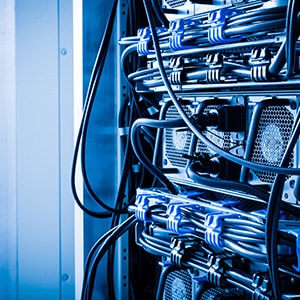Uninterruptible Power Supply (UPS) systems are critical components in ensuring the continuous operation of sensitive and essential equipment by providing backup power during outages and other power disturbances. To enhance the reliability and maintainability of UPS systems, bypass mechanisms are often integrated. Two common types of bypasses are internal bypass and maintenance bypass. This article explores the differences between these two bypass mechanisms, their functionalities, and their applications. 
Internal Bypass
Functionality: Internal bypass, also known as static bypass, is an automatic feature within the UPS system that provides an alternate path for power to flow directly from the input to the output, bypassing the UPS’s internal components such as the inverter and rectifier.
Key Characteristics:
- Automatic Operation: Internal bypass activates automatically when the UPS detects an internal fault or overload condition, allowing the connected load to continue receiving power without interruption.
- Static Switch: Utilizes a static switch (a solid-state device) for fast and seamless transition, ensuring minimal disruption to the load.
- Temporary Solution: Designed for short-term use until the UPS can resume normal operation or until a more permanent solution is implemented.
Applications:
- Overload Protection: Activates during overload conditions to prevent damage to the UPS system.
- Fault Tolerance: Engages when an internal fault is detected, maintaining power supply to critical equipment.
- Seamless Transition: Provides a quick and smooth transfer to bypass mode, ensuring continuous power delivery.
Maintenance Bypass
Functionality: Maintenance bypass is a manual feature that allows the complete isolation of the UPS system for maintenance or repair purposes. It provides a direct path for power to flow from the input to the output, bypassing the entire UPS system.
Key Characteristics:
- Manual Operation: Typically requires manual intervention to activate, ensuring that maintenance personnel can safely work on the UPS system without affecting the connected load.
- External Switch: Often implemented using an external mechanical switch or breaker that can be operated to divert power away from the UPS.
- Long-Term Solution: Used for extended periods during maintenance, repair, or replacement of the UPS system, allowing for safe and uninterrupted operation of the load.
Applications:
- Scheduled Maintenance: Enables safe and efficient maintenance activities on the UPS system without disrupting the power supply to critical equipment.
- Repair and Replacement: Allows for the isolation of the UPS system for repair or replacement, ensuring that the connected load remains powered.
- Testing and Upgrades: Facilitates testing and upgrading of the UPS system without impacting the operational continuity of the load.
Key Differences Between Internal Bypass and Maintenance Bypass
- Activation Method
- Internal Bypass: Activates automatically in response to specific conditions such as overloads or internal faults. It uses a static switch for rapid and seamless transition.
- Maintenance Bypass: Requires manual activation, usually through an external mechanical switch or breaker. It is used to intentionally isolate the UPS for maintenance or repair purposes.
- Duration of Use
- Internal Bypass: Intended for short-term use to maintain power continuity during fault conditions or overloads until normal UPS operation can be restored.
- Maintenance Bypass: Designed for long-term use, providing a direct power path while the UPS is serviced, repaired, or replaced.
- Purpose
- Internal Bypass: Primarily serves to protect the UPS system and connected load during fault conditions or overloads, ensuring seamless power transition.
- Maintenance Bypass: Facilitates safe maintenance, repair, or replacement of the UPS system without interrupting the power supply to the load.
- Implementation
- Internal Bypass: Integrated within the UPS system, utilizing a static switch for automatic and rapid activation.
- Maintenance Bypass: Typically implemented using an external switch or breaker, requiring manual intervention to engage.
Conclusion
Both internal bypass and maintenance bypass are essential features in UPS systems, each serving distinct purposes to enhance the reliability and maintainability of power protection solutions. Internal bypass provides automatic, seamless protection during fault conditions or overloads, ensuring continuous power delivery to critical loads. In contrast, maintenance bypass offers a manual, long-term solution for safely isolating the UPS system during maintenance, repair, or replacement activities.
Understanding the differences between these two bypass mechanisms is crucial for effectively managing and maintaining UPS systems, ensuring that critical equipment remains powered and protected under all circumstances. By integrating both types of bypasses, organizations can achieve greater flexibility, safety, and reliability in their power protection strategies.




























































